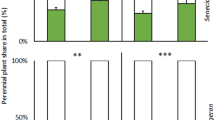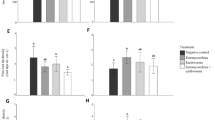Abstract
MOST of the intimate and often beneficial associations formed between plant roots and some soil fungi can be classified as either endomycorrhizas of various types or sheathing (ecto-) mycorrhizas1,2. The latter, in which colonised roots are shorter and thicker than their uncolonised counterparts, are mainly attributed to basidiomycetous fungi that produce sporophores (toadstools) typical of the Agaricales. Sometimes fungi forming sheathing mycorrhizas produce large numbers of sporophores. P. Larsen, quoted by Romell3, estimated sporophore production by the mycorrhizal Suillus bovinus (Fries) O. Kuntze to be about 180 kg (dry weight) per hectare per yr. Although their evidence is questionable, experiments done by Romell4 and Laiho5 suggest that the mycorrhizal Boletus subtomentosus Fries and Paxillus involutus (Batsch ex Fr.) Fr. usually form sporophores only if they are organically linked to living trees. Hacskaylo6 found that shading foliage of Pinus virginiana Mill decreased sporophore formation by Thelephora terrestris Fr. The results reported here extend the understanding of this relation by showing that sporophore production by some mycorrhizal associates of birch (Betula spp.) is strongly dependent, in the field, on the presence of green foliage.
This is a preview of subscription content, access via your institution
Access options
Subscribe to this journal
Receive 51 print issues and online access
$199.00 per year
only $3.90 per issue
Buy this article
- Purchase on Springer Link
- Instant access to full article PDF
Prices may be subject to local taxes which are calculated during checkout
Similar content being viewed by others
References
Harley, J. L. Oxford Univ. Press Biol. Reader No. 12, Mycorrhiza (Oxford University Press, 1971).
Marks, G. C. & Foster, R. C. in Ectomycorrhizae, their Ecology and Physiology (ed. Marks, G. C. & Kozlowski, T. T.) (Academic, New York & London, 1973).
Romell, L. G. Svensk. Bot. Tidskr. 32, 87–99 (1938).
Romell, L. G. Svenska SkogsvFör Tidskr. 37, 348–375 (1939).
Laiho, O. Acta For. fenn. 106, 1–72 (1970).
Hacskaylo, E. Forest Sci. 11, 401–404 (1965).
Lewis, D. H. Biol. Rev. 48, 261–278 (1973).
Harley, J. L. J. Ecol. 59, 653–668 (1971).
Pegg, G. F. Trans. Br. mycol. Soc. 61, 227–286 (1973).
Author information
Authors and Affiliations
Rights and permissions
About this article
Cite this article
LAST, F., PELHAM, J., MASON, P. et al. Influence of leaves on sporophore production by fungi forming sheathing mycorrhizas with Betula spp.. Nature 280, 168–169 (1979). https://doi.org/10.1038/280168a0
Received:
Accepted:
Published:
Issue Date:
DOI: https://doi.org/10.1038/280168a0
Comments
By submitting a comment you agree to abide by our Terms and Community Guidelines. If you find something abusive or that does not comply with our terms or guidelines please flag it as inappropriate.



